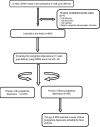Low serum levels of High-Density Lipoprotein cholesterol (HDL-c) as an indicator for the development of severe postpartum depressive symptoms
- PMID: 29444162
- PMCID: PMC5812627
- DOI: 10.1371/journal.pone.0192811
Low serum levels of High-Density Lipoprotein cholesterol (HDL-c) as an indicator for the development of severe postpartum depressive symptoms
Abstract
Postpartum depression (PPD) is a psychiatric complication of childbirth affecting 10-20% of new mothers and has negative impact on both mother and infant. Serum lipid levels have been related to depressive disorders, but very limited literatures are available regarding the lipid levels in women with postpartum depression. The present study is aimed to examine the association of serum lipids with the development of postpartum depressive symptoms. This is a cross sectional study conducted at a tertiary care hospital in South India. Women who came for postpartum check-up at 6th week post-delivery were screened for PPD (September 2014-October 2015). Women with depressive symptoms were assessed using EPDS (Edinburgh Postnatal Depression Scale). The study involved 186 cases and 250 controls matched for age and BMI. Serum levels of lipid parameters were estimated through spectrophotometry and the atherogenic indices were calculated in all the subjects. Low serum levels of Total Cholesterol (TC) and High Density Lipoprotein cholesterol (HDL-c) were significantly low in PPD women with severe depressive symptoms. The study recorded a significant negative correlation between HDL-c and the EPDS score in PPD women (r = -0.140, p = 0.05). Interestingly, the study also observed a significant negative correlation between Body Mass Index (BMI) and EPDS scores in case group (r = -0.146, p = 0.047), whereas a positive correlation between the same in controls (r = 0.187, p = 0.004). Our study demonstrated that low levels of serum HDL-c is correlated with the development of severe depressive symptoms in postpartum women. Study highlights the role of lipids in the development of postpartum depressive symptoms.
Conflict of interest statement
References
-
- Buttner M, O'Hara MW, Watson D. The structure of women’s mood in the early postpartum. Assessment 2012; 19: 247–56. doi: 10.1177/1073191111429388 - DOI - PubMed
-
- Vliegen N, Casalin S, Luyten P. The course of postpartum depression: a review of longitudinal studies. Har Rev of Psychiatry 2014; 22(1):1–22. - PubMed
-
- Savarimuthu R, Ezhilarasu P, Charles H, Antonisamy B, Kurian S, Jacob K. Post-partum depression in the community: a qualitative study from rural South India. Int J Soc Psychiatry 2010; 56: 94–102. doi: 10.1177/0020764008097756 - DOI - PubMed
-
- Azorin JM, Angst J, Gamma A, Bowden CL, Perugi G, Vieta E et al. Identifying features of bipolarity in patients with first-episode postpartum depression: findings from the international BRIDGE study. J Affect Disord 2012; 136:710–15. doi: 10.1016/j.jad.2011.10.003 - DOI - PubMed
MeSH terms
Substances
LinkOut - more resources
Full Text Sources
Other Literature Sources
Medical


